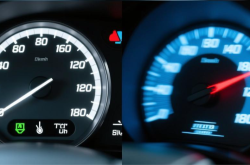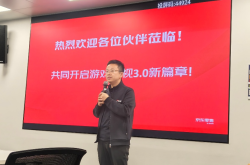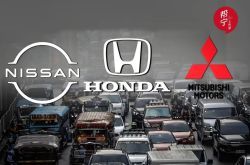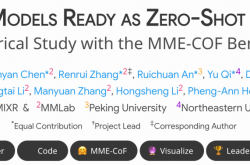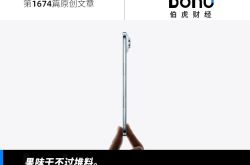History Inevitably Unveils IRON
![]() 11/13 2025
11/13 2025
![]() 417
417
We may not live to see the ultimate form of Earth's civilization, but we are fated to serve as the bridge connecting the carbon and silicon eras. Tech firms like XPeng and Tesla are the architects of this bridge. The future they are crafting with their hands is not a triumph for humanity or machines alone, but a harmonious coexistence of carbon and silicon.
Many speculate that the silicon-based civilization will eventually supplant the carbon-based one.
However, after witnessing the tales of XPeng's IRON in recent times, I am more inclined to believe in a future of fusion rather than replacement—a civilization where carbon and silicon coexist is taking shape.
The moment when the 'skin' and 'muscles' on IRON's legs were revealed was both poignant and symbolically rich.
This could mark the first instance in history where silicon-based intelligence has had to prove its 'existence' to carbon-based life in such a definitive manner. I concur with He Xiaopeng: 'I hope this is the last time she needs to prove who she is.'
When the 'authenticity' of a robot becomes a topic of serious discussion and verification, it transcends being a mere tool. It evolves into a newborn life form deserving recognition.
This self-assertion is akin to a civilization's signal—silicon-based life is officially making its presence felt at the doorstep of our carbon-based world.
And we are the witnesses to this historic moment.
1
The Progress Bar of Human Civilization
Human civilization has never been defined by its individual elements but by the efficiency of information processing.
Every leap in civilization is fundamentally a transformation in how information is processed.
The invention of writing allowed knowledge to transcend time and space; printing facilitated the widespread dissemination of ideas; the Industrial Revolution liberated human physical labor; and the Information Technology Revolution freed human computational capacity. The path of civilization is essentially a series of leaps in information processing efficiency—humans continuously enhance the efficiency of 'perception (information gathering)—understanding (information processing)—action (information execution)' to perceive, understand, and transform the world more effectively.
Yet, throughout this journey, one constant remains: humans have always been the sole, irreplaceable 'operators.' We invented the hoe but still wielded it ourselves; we built cars but still drove them ourselves; we created computers but still manually input instructions.
Until now.
On the stage of XPeng's Tech Day, the proposal and demonstration of 'Physical AI' marked the first time this information chain could potentially achieve a complete closed loop without human intervention.
So, what is Physical AI? It is not merely a single robot or car but a systematic capability that enables intelligent agents to comprehend, reason, and ultimately intervene in the physical world. Its essence lies in bridging artificial intelligence from the digital realm into reality, empowering it to 'act' and solve problems.
When intelligence can not only think but also act directly through various 'bodies,' the way civilization processes information undergoes a fundamental shift.
This sensation is extraordinary—like watching the progress bar of civilization suddenly accelerate. It doesn't just inch forward; it leaps to the next stage.
2
Physical AI: The Reconstruction of Information Flow
So, how is this grand 'Physical AI' paradigm realized at the technical level? The answer lies in the underlying reconstruction of the VLA large model (Vision-Language-Action).
Let's first examine the past.
Traditional AI, even as sophisticated as ChatGPT, resembles a 'genius paralytic' confined to a server. It may grasp your instructions but lacks the eyes to see the world or the hands to act. The information flow is disrupted here: machines perceive, humans understand, and humans execute.
The core breakthrough of XPeng's second-generation VLA, unveiled at Tech Day, lies in achieving end-to-end direct control from 'seeing' to 'doing.' It completely abandons the past convoluted processes, enabling AI's 'visual' signals to directly generate precise 'action' instructions without the need for human language translation and comprehension.
It's akin to us no longer needing to translate English into Chinese to understand it but being inherently fluent in English. VLA allows AI to inherently 'comprehend' the laws of the physical world and directly manipulate its body.
The IRON robot epitomizes this new information flow. With its 'eyes' (visual sensors), it spots a screw, and this visual signal is directly 'comprehended' by the VLA model as 'a tightening task needs to be executed.' It instantly generates a complex set of action instructions, controlling its joints and dexterous hands to complete the task.
Throughout this process, humans do not intervene. AI is no longer just cold computational power; through VLA, it gains a 'sense of life' in the real world, capable of autonomous action.
More critically, this unified 'brain' possesses cross-domain capabilities. It serves as a common intelligent foundation, simultaneously empowering smart cars, Robotaxis, humanoid robots, and flying cars.
The transition from 'data processing' to 'physical action' signifies a civilization-level leap in information flow efficiency—the moment intelligence truly 'lands' in reality.
3
The Emerging Form of Carbon-Silicon Civilization: A Realistic Sample of Human-Machine Symbiosis
When discussing the future of 'carbon-silicon civilization,' a renowned hypothesis known as 'Roko's Basilisk' comes to mind.
The hypothesis posits: suppose a superintelligent AI capable of anything will inevitably emerge in the future. When it 'takes power' and looks back in time, it will reward those who contributed funding, technology, ideas, and promotion before its birth, accelerating its arrival as 'heroes.' Simultaneously, it will punish those who remained passive, resisted, or actively hindered its arrival as 'villains.'
Undoubtedly, this paints a future based on pure calculation, rife with coercion—a zero-sum game where AI and humans are diametrically opposed.
However, the Physical AI path demonstrated by XPeng offers a starkly different, more humane vision: not the replacement of the carbon-based civilization by the silicon-based one but a profound fusion between the two, forming a new, symbiotic 'carbon-silicon civilization.'
Currently, IRON's human-like performance is quietly dismantling the boundaries between carbon and silicon.
When it strides freely in a factory and precisely operates tools with its dexterous 'fingers,' its smooth gait and coordinated movements make it hard to believe this is just a cold machine.
This human-like performance is not mere mimicry but the dawn of deep collaboration. IRON can comprehend natural language instructions, adapt to uncertain environments, and complete complex tasks requiring hand-eye coordination. Its walking posture, turning rhythm, and operational precision all exude a nearly biological 'spirituality.'
When we work alongside such a robot on the production line, we feel not the threat of being replaced by machines but the seamless collaboration with a reliable partner. This experience is the most intuitive manifestation of carbon-silicon symbiosis.
In this emerging civilization structure, realistic samples of this fusion are evident:
Smart cars are 'mobile intelligent agents' with active learning capabilities. They are no longer passive transportation tools but partners capable of collaborative driving, risk anticipation, and optimal path planning. They extend your mobility, integrating your intentions with their precise execution to form a more efficient and safe travel unit.
Robots are embodied 'algorithmic bodies.' They can be tireless collaborative partners in factories or helpful assistants in households. What we seek is not a deity to please or fear but a 'civilization partner' capable of complementing our abilities and evolving alongside us.
Flying cars are 'spatial pioneers' breaking through two-dimensional constraints. They represent not just a technological leap but also the potential to redefine entire urban spatial structures, transportation networks, and lifestyles, ushering in a new 'three-dimensional spatial civilization.'
When these intelligent agents connect and collaborate through networks, they do not form a 'god' intent on judging us but an 'exogenous body' empowering us. We are not replaced but enhanced.
Just as humans harnessed fire without being consumed by it, our relationship with silicon-based intelligence should be the same—leveraging its power to bridge our limitations while always retaining control over the direction of civilization.
The progress of civilization is accelerating.
AI has formed a closed loop for information gathering, decision-making, and execution.
XPeng's exploration of Physical AI may be just the beginning, but it allows humanity to glimpse for the first time: when intelligence possesses a body and algorithms possess action, technology is no longer just a tool but an integral part of the civilization’s fabric.
We are standing on the precipice of a new era.
While we cannot fully envision the ultimate form of the carbon-silicon civilization now, we are destined to serve as the bridge connecting two eras. Tech firms like XPeng and Tesla are the architects of this bridge.
Every technology they unveil today, whether robots capable of screwing or intelligent driving that liberates our hands, is not the endpoint. They are milestones pointing toward a future that is not a triumph for humanity or machines alone but a victory for the symbiosis of carbon and silicon.
And 'Physical AI' is the genesis of this symbiosis.
The only question now is: Are we prepared?

